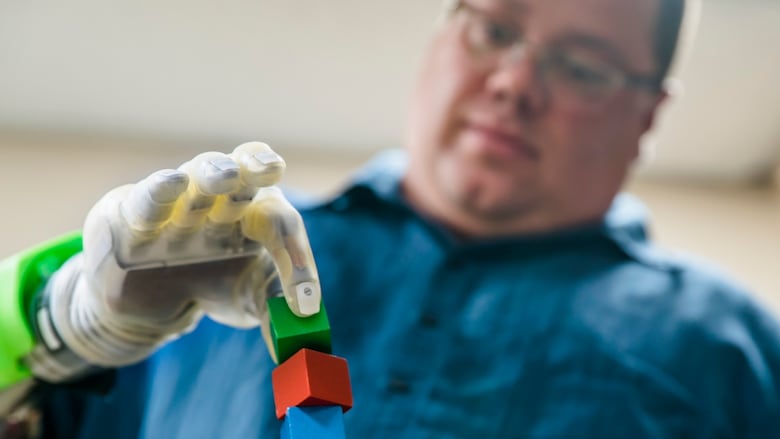'It's like you have a hand again': A major breakthrough in robotic limb technology
Grafting tiny bits of muscle to amputated nerves provides a way to control a robotic limb

Researchers with the University of Michigan have announced a breakthrough in nerve-controlled prosthetic technology, which allows amputees the ability to control their hands and fingers precisely, intuitively, and in real time.
They're claiming it as a major advancement in mind-controlled prosthetics.
"The idea of trying to get a prosthetic control signal from a nerve has been around at least as long as Empire Strikes Back," Cindy Chestek told Quirks & Quarks host Bob McDonald. "It's just been really hard to do because the physics is not in your favour."
While the robotic technology in prosthetic hands has come a long way in recent years, the way to control them has been limited.
"You're talking about extremely small wires, with very small currents and voltages, and you're trying to record that somehow, and if you start putting wires into nerves, that causes a lot of scarring," said Chestek, an associate professor of biomedical engineering at the University of Michigan.
Giving the nerves a megaphone
After an amputation, the nerves continue to function, often leading to what is called a phantom limb, where a patient feels like their limb is still there. Chestek's colleague, Dr. Paul Cederna, devised a way to separate thick residual nerve bundles into smaller fibres, and graft tiny pieces of muscle around them to amplify their signal — essentially, giving the nerves a megaphone.
"It makes the nerve happy because nerves try to regrow until they find a good target, and that can be really painful," said Chestek. "And what it does for us on the engineering side is it takes that tiny signal from a nerve and makes it 10 or 100 times bigger."

Chestek and her team then developed an algorithm to take that amplified signal and send it to the robotic limb in real time, allowing patients to control their limb by just thinking about what they want it to do. Sure enough, by using the amplified signals, the participants were able to use their robotic limbs right away.
"I was telling our participant, 'It might not work on the first try. We might have to debug our code, you know. Like, please bear with us if it doesn't work.' And he just starts moving the thumb to acquire lots of targets, and he says, 'Hey it looks like it's working!'" said Chestek.
"I mean, I was jumping up and down."
Bringing back a sense of normalcy
Soon, in the lab, participants were able to pick up blocks, turn keys, lift spherically shaped objects, and move their thumb in multiple directions.
"It brings you back to a sense of normalcy," said Joe Hamilton, who lost his hand in a fireworks accident in 2013. "It's like you have a hand again."
The team is now working on making the system portable — so far it has only been used in the lab — and seeing what else they can do with these amplified nerve signals.
"We're coming up against the limits of the prosthesis at this point. Like now we want it to go faster. We want it to be lighter," said Chestek. "We're hoping that this motivates better prosthetic hands so that we can use some of the additional signals."
Written and produced by Amanda Buckiewicz